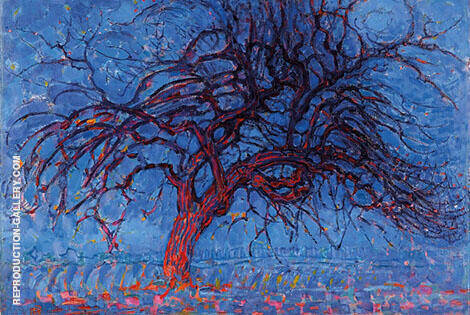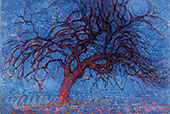Red Tree By Piet Mondrian
The Red Tree by Piet Mondrian is among the artist's most famous paintings and is particularly intriguing.
This oil on canvas painting is relatively small at just 70 by 99 centimeters in the original size. However, it creates a massive impression.
It’s also one of our most popular famous painting replicas, celebrated for its unique combination of serenity and dynamism. So, what is the story behind this iconic Mondrian tree painting?
When did Mondrian create his Red Tree painting?
Painted in 1908, The Red Tree is one of the most critical images in Mondrian’s famous tree paintings series. This year, he also created another renowned artwork, The Windmill in Sunlight.
The expressive brushwork and vivid colors show Mondrian’s experimentation with new styles and techniques. For example, Mondrian notably experimented with “luminism.” This movement focused on light effects and simplified contours.
Where is Mondrian's painting?
Mondrian’s Red Tree painting currently hangs in the Kunstmuseum Den Haag in the Netherlands. They preface its name with the label Avond (Evening).
This Mondrian tree painting appeared during his stay in Domburg in the Netherlands. As a coastal resort, the sea and bright sunshine informed Mondrian’s choice of vibrant coloring.
During his stay in Domburg, Mondrian created many sketches of a particular apple tree. This tree stood in the garden of the Villa Loverendale.
As the home of the painter Jacoba van Heemskerck and Marie Tak van Poortvliet, it inspired several Mondrian artworks. These paintings included The Gray Tree and Trees in Blossom (both painted in 1912).
Why did Piet Mondrian paint The Red Tree?
Mondrian set out a complete vision of nature and the world around him with The Red Tree. Yet, despite the tree’s vivid, violent red, a sense of calm pervades the entire image.
Mondrian produced several sketches for the painting, treating its form and branches with extreme care. First, he flattens the traditional perspective, using linear brush strokes to create an entirely two-dimensional effect.
This artwork shows Mondrian’s stylistic journey towards simplified colors and abstracted forms. These experiments resulted in Mondrian’s best-known creations. Composition with Red, Blue, and Yellow (1930) and Broadway Boogie-Woogie (1943) are just two of the most famous.
In 1908 however, color was Mondrian’s primary concern. As a result, he moved away from earlier explorations of “tonalism,” which focused on tonal values rather than contrasting shades. Indeed, tonalist ideas inspired earlier Mondrian artworks such as Farm at Duivendrecht (1905).
For Mondrian, Vincent van Gogh’s post-impressionist works were a significant influence. Indeed, in The Red Tree’s primary colors, thick impasto paint, and swirling sky, the effect of Van Gogh is evident. Compared with Van Gogh’s artworks, such as Olive Grove (1889), these links are even more apparent.
Van Gogh also associated deep blue with infinity. This theory explains both paintings’ calm aura. With red colors jumping forwards from the canvas and blues receding, Mondrian also creates an image that’s in complete equilibrium.
What do trees symbolize in art?
As one of our most popular oil painting reproductions, Mondrian’s The Red Tree means many different things to different people.
Throughout art history, trees symbolize many essential ideas. They stand for themes of growth, death, and revival. Trees also play significant roles in mythology, explaining their frequent prominence in classical painting.
Trees can represent how people grow more robust and increase their knowledge throughout life, as well as individuality and solidness. Their deep roots and soaring branches inspire the imagination and instill a connection with nature.
In addition, trees allow painters (such as Mondrian) to practice their observation and painterly skills. Trees are notoriously difficult to represent. However, with their many branches, detailed bark, leaves, and complex perspective, many artists use trees as learning aids and studies.
Buy Famous Art Reproductions
Paintings of trees are the subject matter of many famous paintings, with van Gogh Grove Olive tree paintings Olive Trees with Yellow Sky and Sun 1889 and Olive Trees 1889 and Gustav Klimt Beech Forest 1902
Discover over 400 reproduction paintings on canvas from our tree wall art catalog of replica oil paintings.
We offer a 100% money back guarantee or replacement service. If for any reason you are dissatisfied with your painting please contact us within 7 days of receipt, advising the reason you are unhappy and we will provide you with all the information you need for its return or replacement.
We ship free to anywhere in the world via FedEx or DHL expedited service with online tracking.
Your painting will be shipped rolled in strong plastic tubing, ready for stretching and/or framing locally. This is the conventional method of transporting hand-painted oil on canvas. Learn more about how your painting is shipped.
We are able to offer a framing service intercontinental U.S. Please contact us if you would like a quotation. Alternatively, should you prefer, we can recommend a framer in your area.
Notes About Your Painting
Please note that replica oil paintings are finished with an additional 10cm (4") of extra canvas on all sides, allowing ample surplus canvas for stretching and framing.
Recently Viewed:
Cannot Find What You Are Looking For?
Reproduction Gallery Information
Customer Service
(Send Us A Message)
Tel: (503) 937 2010
Fax: (503) 937 2011







